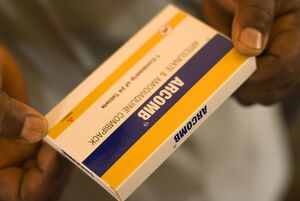Artesunate/amodiaquine
 Package of medication in Nigeria | |
| Combination of | |
|---|---|
| Artesunate | Antimalarial |
| Amodiaquine | Antimalarial |
| Names | |
| Trade names | Camoquin, others[1] |
| Other names | ASAQ |
| Clinical data | |
| Pregnancy category |
|
| Routes of use | By mouth[2] |
| Defined daily dose | Not established[3] |
Artesunate/amodiaquine, sold under the trade name Camoquin among others, is a medication used for the treatment of malaria.[4][5] It is a fixed-dose combination of artesunate and amodiaquine.[4] Specifically it recommended for acute uncomplicated Plasmodium falciparum malaria.[6] It is taken by mouth.[3]
Common side effects include loss of appetite, nausea, abdominal pain, sleepiness, trouble sleeping, and cough.[7] Safety in pregnancy is not clear; however, the medication may be used if others are not possible.[7] It is believed to be safe for use during breastfeeding.[7] Artesunate and amodiaquine are both antimalarial medication; however, work by different mechanisms.[7]
Artesunate/amodiaquine was commercially launched in 2007.[8] It is on the World Health Organization's List of Essential Medicines.[4] Artesunate/amodiaquine is available as a generic medication.[8] The wholesale cost in the developing world is about US$0.85 to US$1.52 for a course of treatment.[3] As of 2014 it is not commercially available in the United States or United Kingdom.[1][9]
Medical uses
Early clinical trials showed that a once-a-day dosage was effective.[10] It was subsequently shown to be equally effective as artemether/lumefantrine,[11] although it is likely to be more effective in the field due to its simpler once-a-day dosage compared to artemether/lumefantrine twice-per-day dosage.
Dosage
The defined daily dose is not established.[2] For those who weight more than 35 kg the dose is 200/540 mg one a day, for those who weight 18 to 35 kg the dose is 100/270 mg once a day, for those who weight 9 to 18 kg the dose is 50/135 mg once per day, and for those who weight 4.5 to 9 kg the dose is 25/67.5 mg once per day.[12] Treatment is for three days.[12]
Society and culture
Artesunate/amodiaquine was commercially launched in 2007 as an affordable treatment for malaria, devised by DNDi in partnership with Sanofi-Aventis.[8] ASAQ was handed over to the MMV Access and Product Management Team in May 2015.[13]
References
- ↑ 1.0 1.1 Ainsworth, Sean B. (2014). Neonatal Formulary: Drug Use in Pregnancy and the First Year of Life. John Wiley & Sons. p. 75. ISBN 9781118819517. Archived from the original on 2016-12-20.
- ↑ 2.0 2.1 "WHOCC - ATC/DDD Index". www.whocc.no. Archived from the original on 19 August 2020. Retrieved 20 September 2020.
- ↑ 3.0 3.1 3.2 "Artesunate + Amodiaquine". International Drug Price Indicator Guide. Archived from the original on 22 January 2018. Retrieved 8 December 2016. Cite error: Invalid
<ref>tag; name "ERC2014" defined multiple times with different content - ↑ 4.0 4.1 4.2 World Health Organization (2019). World Health Organization model list of essential medicines: 21st list 2019. Geneva: World Health Organization. hdl:10665/325771. WHO/MVP/EMP/IAU/2019.06. License: CC BY-NC-SA 3.0 IGO.
- ↑ Oyakhirome S, Pötschke M, Schwarz NG, et al. (March 2007). "Artesunate--amodiaquine combination therapy for falciparum malaria in young Gabonese children". Malar. J. 6: 29. doi:10.1186/1475-2875-6-29. PMC 1831475. PMID 17352806.
- ↑ World Health Organization (2009). Stuart MC, Kouimtzi M, Hill SR (eds.). WHO Model Formulary 2008. World Health Organization. p. 187. hdl:10665/44053. ISBN 9789241547659.
- ↑ 7.0 7.1 7.2 7.3 "Artesunate Amodiaquine Winthrop" (PDF). WIPO. August 2010. Archived (PDF) from the original on 24 October 2016. Retrieved 12 December 2016.
- ↑ 8.0 8.1 8.2 "New, Once-a-Day Fixed-Dose Combination Against Malaria Now Available – DNDi". www.dndi.org. 1 March 2007. Archived from the original on 20 December 2016. Retrieved 12 December 2016.
- ↑ Goldman, Lee; Schafer, Andrew I. (2015). Goldman-Cecil Medicine. Elsevier Health Sciences. p. 2112. ISBN 9780323322850. Archived from the original on 2016-12-20.
- ↑ Ndiaye, Jean; Randrianarivelojosia, Milijaona; Sagara, Issaka; Brasseur, Philippe; Ndiaye, Ibrahima; Faye, Babacar; Randrianasolo, Laurence; Ratsimbasoa, Arsène; Forlemu, Doris; Moor, Vicky; Traore, Aminata; Dicko, Yahia; Dara, Niawanlou; Lameyre, Valérie; Diallo, Mouctar; Djimde, Abdoulaye; Same-Ekobo, Albert; Gaye, Oumar (June 2009). "Randomized, multicentre assessment of the efficacy and safety of ASAQ – a fixed-dose artesunate-amodiaquine combination therapy in the treatment of uncomplicated Plasmodium falciparum malaria". Malaria Journal. 8: 125. doi:10.1186/1475-2875-8-125. PMC 2698916. PMID 19505304. Archived from the original on 19 September 2011. Retrieved 18 January 2013.
- ↑ Nidiaye, Jean-Louis A; Faye, Babacar; Gueye, Ali; Tine, Roger; Ndiaye, Daouda; Tchania, Corinne; Ndiaye, Ibrahima; Barry, Aichatou; Cissé, Badara; Lameyre, Valérie; Gaye, Oumar (2011). "Repeated treatment of recurrent uncomplicated Plasmodium falciparum malaria in Senegal with fixed-dose artesunate plus amodiaquine versus fixed-dose artemether plus lumefantrine: a randomized, open-label trial". Malaria Journal. 10: 237. doi:10.1186/1475-2875-10-237. PMC 3171378. PMID 21838909. Archived from the original on 10 October 2014. Retrieved 18 January 2013.
- ↑ 12.0 12.1 "ARTESUNATE/AMODIAQUINE = AS/AQ oral - Essential drugs". medicalguidelines.msf.org. Archived from the original on 24 January 2021. Retrieved 25 August 2020.
- ↑ "DNDi passes the ball to MMV | Medicines for Malaria Venture". www.mmv.org. Archived from the original on 2020-02-13. Retrieved 2020-02-13.
External links
- Patient Leaflet Archived 2013-12-12 at the Wayback Machine
- Monograph (2010) Archived 2021-08-27 at the Wayback Machine
| Identifiers: |
|
|---|
- Pages using duplicate arguments in template calls
- Pages with reference errors
- Chemical articles with unknown parameter in Infobox drug
- Chemical articles without CAS registry number
- Articles without EBI source
- Chemical pages without ChemSpiderID
- Chemical pages without DrugBank identifier
- Articles without KEGG source
- Articles without InChI source
- Articles without UNII source
- Drugs missing an ATC code
- Drugs with no legal status
- Drugboxes which contain changes to verified fields
- Drugs that are a combination of chemicals
- Webarchive template wayback links
- Articles with changed CASNo identifier
- Chemicals that do not have a ChemSpider ID assigned
- Antimalarial agents
- Combination drugs
- World Health Organization essential medicines
- RTT